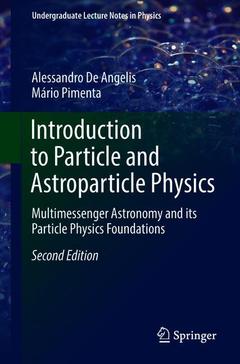Introduction to Particle and Astroparticle Physics (2nd Ed., 2nd ed. 2018) Multimessenger Astronomy and its Particle Physics Foundations Undergraduate Lecture Notes in Physics Series
Auteurs : De Angelis Alessandro, Pimenta Mário

This book introduces particle physics, astrophysics and cosmology. Starting from an experimental perspective, it provides a unified view of these fields that reflects the very rapid advances being made. This new edition has a number of improvements and has been updated to describe the recent discovery of gravitational waves and astrophysical neutrinos, which started the new era of multimessenger astrophysics; it also includes new results on the Higgs particle. Astroparticle and particle physics share a common problem: we still don?t have a description of the main ingredients of the Universe from the point of view of its energy budget. Addressing these fascinating issues, and offering a balanced introduction to particle and astroparticle physics that requires only a basic understanding of quantum and classical physics, this book is a valuable resource, particularly for advanced undergraduate students and for those embarking on graduate courses. It includes exercises that offer readers practical insights. It can be used equally well as a self-study book, a reference and a textbook.
Understanding the universe: particles and their interactions.- The birth and the basics of particle physics.- Cosmic rays and the development of particle physics.- Particle detection.- Particles and symmetries.- Interactions and field theories.- The Higgs mechanism and the standard model of particle physics.- The standard model of cosmology and the dark universe.- Neutrino oscillations and masses.- Messengers from the high-energy universe.- Astrobiology, and the relation of fundamental physics to life.
Alessandro de Angelis is a high energy physicist and astrophysicist. Professor at the Universities of Udine, Padua and Lisbon, he is currently the Principal Investigator of the proposed space mission e-ASTROGAM and for many years has been director of research at INFN Padua, and scientific coordinator and chairman of the board managing the MAGIC gamma-ray telescopes in the Canary Island of La Palma. His main research interest is on fundamental physics, especially astrophysics and elementary particle physics at accelerators. He graduated from Padua, was employed at CERN for seven years in the 1990s ending as a staff member, and later was among the founding members of NASA's Fermi gamma-ray telescope. His original scientific contributions have been mostly related to electromagnetic calorimeters, advanced trigger systems, QCD, artificial neural networks, and to the study of the cosmological propagation of photons. He has taught electromagnetism and astroparticle physics in Italy and Portugal and has been a visiting professor in the ICRR of Tokyo, at the Max-Planck Institute in Munich, and at the University of Paris VI.
Mário Pimenta is a high energy physicist and astrophysicist. Professor at the Instituto Superior Técnico of the University of Lisbon, he is currently the president of the Portuguese national organization for Particle and Astroparticle Physics, coordinator of the international PhD doctoral network IDPASC, and the representative for Portugal at the Pierre Auger Observatory in Argentina. Formerly member of the WA72, WA74, NA38 and DELPHI experiments at CERN and of the EUSO collaboration at ESA, his main interest of research is on high-energy physics, especially cosmic rays of extremely high energy and development of detectors for astroparticle physics. He graduated from Lisbon and Paris VI, and was employed at CERN in the late 1980s. His original contributions have been mostly related to advanced trigger systems
Date de parution : 06-2018
Ouvrage de 733 p.
15.5x23.5 cm
Thèmes d’Introduction to Particle and Astroparticle Physics :
Mots-clés :
Particle physics textbook; Cosmology Introduction; Neutrino oscillations and masses; High-Energy Astrophysics textbook; Astrophysics textbook; Particle detection; Particles and symmetries; Messengers from the high-energy universe; The Higgs mechanism; Detectors and Instruments for High-Energy Physics; Gravitational waves discover



